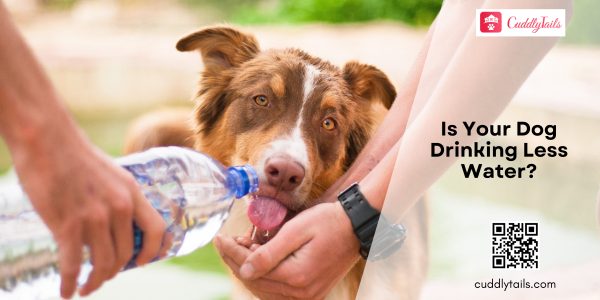Inadequate Water Consumption in Dogs: Dangers, Reasons, and Cure
Water is the foundation of life, and for dogs, it is just as essential as food. Adequate hydration helps regulate body temperature, transport nutrients, flush toxins, and keep organs functioning smoothly. But what happens when your dog isn’t drinking enough water? Inadequate water consumption can lead to dehydration, health complications, and, if ignored, even life-threatening conditions.
Why Water Is Essential for Dogs
Role of Hydration in Canine Health
Water makes up over 60% of a dog’s body weight and is vital for digestion, circulation, joint lubrication, and temperature regulation. A hydrated dog can stay active, alert, and comfortable, while dehydration quickly impacts energy levels and organ function.
How Much Water Do Dogs Need?
On average, dogs require about 1 ounce of water per pound of body weight per day. However, this amount may increase depending on activity levels, diet (dry food vs. wet food), and environmental conditions.
Dangers of Dog Drinking Less Water
Dehydration and Its Consequences
When dogs don’t drink enough water, they can become dehydrated. Dehydration leads to dry gums, loss of skin elasticity, sunken eyes, and lethargy. Left untreated, it can escalate to shock and organ failure.
Kidney and Urinary Problems
Chronic low water intake strains the kidneys and bladder. This can increase the risk of kidney stones, urinary tract infections (UTIs), and, in severe cases, kidney failure.
Heatstroke Risk
In hot weather, inadequate hydration makes dogs more prone to overheating. Without enough water to regulate body temperature, dogs can develop heatstroke, which is a medical emergency.
Signs of Dehydration in Dogs
Physical Symptoms
Common signs include sticky gums, dry nose, loss of appetite, decreased urination, and lethargy. Severe cases may show rapid heart rate, collapse, or confusion.
Skin Elasticity Test
One quick way to check hydration is to gently lift the skin between your dog’s shoulders. In a hydrated dog, the skin snaps back quickly; in a dehydrated dog, it returns slowly.
Reasons Why Your Dog Is Drinking Less Water
Health Conditions
Underlying illnesses such as kidney disease, diabetes, or oral pain can reduce a dog’s willingness or ability to drink. Sometimes, nausea or gastrointestinal discomfort discourages water intake.
Environmental Factors
Cold weather may naturally reduce a dog’s thirst. Similarly, unclean or stale water, or bowls placed in uncomfortable spots, can cause them to avoid drinking.
Dietary Influence
Dogs on wet food diets often consume less water because their food already provides moisture. In contrast, dogs eating dry kibble without additional water may risk dehydration.
Behavioral and Psychological Causes
Stress, anxiety, or changes in environment (such as moving homes or traveling) can reduce a dog’s interest in drinking water.
How to Encourage Your Dog to Drink More Water
Fresh and Accessible Water
Always provide clean, fresh water in multiple accessible locations. Wash bowls daily to avoid bacteria buildup.
Flavoring and Variety
Adding low-sodium chicken broth, ice cubes, or pet-safe water enhancers can encourage picky drinkers. Some dogs also prefer running water from pet fountains.
Wet Food and Hydration
Switching from dry kibble to wet or mixed food can increase your dog’s water intake naturally.
Temperature Considerations
Dogs often prefer cool water, especially in warm weather. Offering ice cubes or chilled water may make drinking more appealing.
Contact Your Veterinarian
Call your vet immediately if your dog refuses water for long, shows dehydration signs, or has related symptoms (e.g., vomiting, lethargy). Describe drinking habits, urine output, and any triggers (e.g., new diet, hot weather).
You can reach out to a Cuddlytails vet here.
Treatment For a Dog Drinking Less Water
Veterinary Care for Severe Cases
If your dog shows signs of dehydration, your vet may recommend intravenous (IV) fluids, subcutaneous fluids, or hospitalization to restore balance.
Addressing Underlying Causes
If inadequate drinking is due to illness, dental pain, or urinary problems, treating the root cause is essential.
Ongoing Management
In mild cases, home management by encouraging water intake and monitoring hydration may be sufficient, but consistent follow-up with your vet ensures safety.
Prevention and Long-Term Care
Regular Monitoring
Keep track of your dog’s drinking habits, especially during seasonal changes or illness. Dogs that suddenly drink less may need prompt medical evaluation.
Balanced Diet
A diet with the right moisture balance reduces the risk of dehydration. Wet food, hydrating treats, and avoiding excess salt in snacks support healthy hydration.
Environmental Adjustments
Provide shaded rest areas, keep water bowls in comfortable spots, and avoid prolonged exposure to heat.
Promote Hydration-Friendly Habits
Offer fresh water in appealing formats (e.g., fountains, wide bowls) and refresh it daily. Feed moisture-rich diets (e.g., wet food or soaked kibble) to supplement water intake. Encourage drinking by placing bowls in multiple locations, especially for multi-pet households or large homes.
Conclusion
Inadequate water consumption may seem minor, but it can have serious consequences for your dog’s health. From dehydration to kidney strain, the risks are real and preventable. By recognizing the reasons behind low water intake, encouraging healthy drinking habits, and seeking veterinary help when needed, you can ensure your dog stays happy, healthy, and well-hydrated.
FAQs
Why isn’t my dog drinking enough water?
Causes include unappealing water, stress, dental pain, kidney disease, or diabetes. A vet can diagnose with blood work or exams.
Is low water intake an emergency?
Seek emergency care for severe dehydration (collapse, sunken eyes) or persistent vomiting/diarrhea, indicating serious conditions like kidney failure.
Can I treat inadequate water consumption at home?
Offer fresh water or wet food, but avoid human electrolyte drinks or forcing water. Consult a vet for underlying causes and treatments.
How can I prevent low water intake?
Provide clean water, use fountains, feed wet food, and maintain regular vet checkups to monitor health and hydration.
What treatments are available for inadequate water consumption?
Treatments include IV fluids for dehydration, medications for underlying conditions (e.g., diabetes, infections), and dietary changes to boost moisture.

